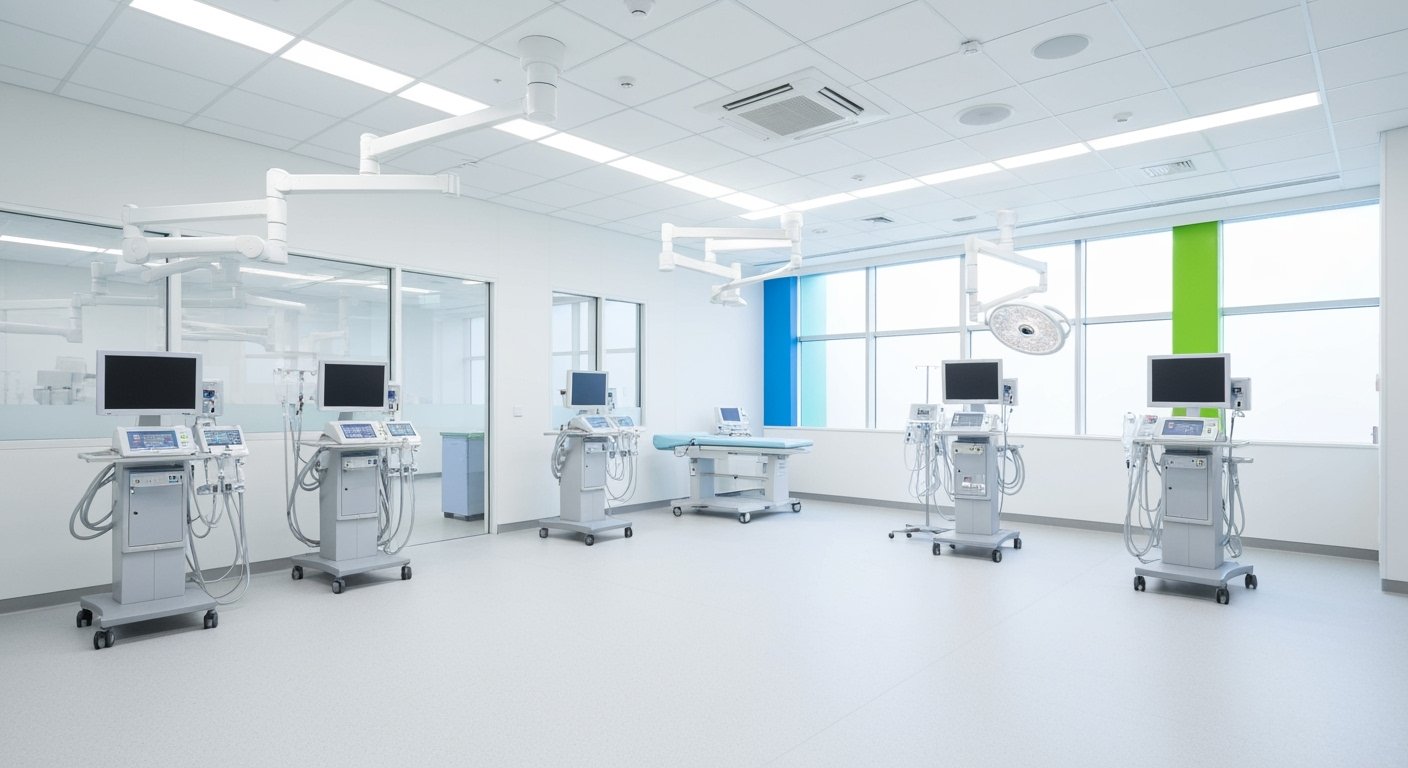Recognizing the Right Time to Address Female Infertility: Key Indicators and Expert Care in Queens

Exploring a Scarless Surgical Alternative
Vaginal Natural Orifice Transluminal Endoscopic Surgery, or vNOTES, is emerging as a transformative approach to hysterectomy that emphasizes minimal invasiveness and maximized patient comfort. For many women facing gynecologic surgery, understanding vNOTES from the patient's perspective offers valuable insights into a procedure that blends advanced endoscopic technology with natural body orifices, resulting in scarless surgery and expedited recovery.
What is vNOTES? Understanding the Procedure Through the Patient's Eyes
Overview of vNOTES
vNOTES, or vaginal natural orifice transluminal endoscopic surgery, is a modern, minimally invasive technique used mainly for hysterectomy—the removal of the uterus. Unlike traditional surgeries that require large abdominal cuts, vNOTES uses the natural opening of the vagina as the entry point. This approach combines advantages from vaginal surgery, laparoscopy, and endoscopy, minimizing visible scars and reducing recovery time.
The operation begins with inserting specialized instruments through a tiny (about 2cm) incision inside the vagina. A device called GelPoint V-Path provides high visibility and access for the surgical tools. The surgeon inflates the abdomen with carbon dioxide gas to create enough room to safely perform the procedure. The entire operation, including removing reproductive organs like the uterus, fallopian tubes, or ovaries, can be completed without any external abdominal cuts.
Surgical steps and anesthesia
vNOTES is performed under general anesthesia, meaning patients are fully asleep and pain-free during the procedure. The surgeon makes a small incision in the vaginal area and inserts the GelPoint device to facilitate surgery. The abdomen is then inflated with carbon dioxide to allow better visualization. The surgeon proceeds to dissect and remove targeted tissue using endoscopic instruments, maintaining a clear view of the pelvic structures.
Postoperative analysis shows that most patients experience less pain after vNOTES compared to traditional surgery, thanks to the minimally invasive nature and lack of large cuts. Most patients can go home within 24 hours and return to normal activities faster.
Use of natural vaginal access
A significant feature of vNOTES is its use of the vagina as the natural surgical pathway. This approach offers better visualization, easier access to the pelvic organs, and less instrument clashing during the surgery. It allows surgeons to see and control critical structures like blood vessels and the ureters effectively.
Because it avoids abdominal incisions, vNOTES results in no visible scars, improving cosmesis and patient satisfaction. It also enables safe treatment even in women with larger uteruses or those without previous childbirth, broadening its accessibility.
Recovery setting and duration
Most women undergoing vNOTES are able to leave the hospital on the same day or within 24 hours. Recovery is typically quicker with less pain and fewer complications. Patients are generally advised to avoid heavy lifting, vigorous exercise, and sexual activity for about six weeks post-surgery.
Postoperative care includes managing discomfort with over-the-counter pain medications, monitoring for bleeding, and following activity restrictions. Early mobility, pelvic exercises, and support from healthcare providers further aid recovery. The minimal scarring and fast discharge make vNOTES an appealing choice for many women seeking gynecologic surgery.
The Scarless Advantage: How vNOTES Enhances Patient Recovery

What are the benefits and advantages of vNOTES scarless hysterectomy for patients?
vNOTES, or Vaginal Natural Orifice Transluminal Endoscopic Surgery, represents a significant advancement in minimally invasive gynecologic surgery. One of its most appreciated benefits is the absence of external abdominal incisions, which means patients experience no visible scars after surgery. This not only improves cosmetic outcomes but also contributes positively to psychological well-being by reducing the stigma or self-consciousness related to surgical scars.
Patients undergoing vNOTES report less postoperative pain compared to traditional laparoscopic methods. Because the procedure involves inserting specialized instruments through the natural orifice of the vagina, it avoids large abdominal cuts, thereby minimizing tissue trauma. These benefits often translate into a quicker recovery, allowing many patients to manage postoperative discomfort with over-the-counter medications.
The approach also shortens hospital stays and supports outpatient management, with most women able to go home within 24 hours. The decreased trauma, coupled with less pain and faster mobilization, accelerates postoperative convalescence. Patients often return to normal activities sooner, which can enhance their overall satisfaction and reduce time away from work or daily routines.
Cosmetically, vNOTES offers a clear advantage. Since there are no abdominal scars, women often feel more comfortable during recovery and in daily life. The psychological impact of scarless surgery is significant, contributing to a more positive outlook on treatment outcomes.
Surgeon ergonomics are improved as well, with better instrument maneuverability and visualization. This can lead to fewer complications and makes it feasible to perform complex cases, such as those involving larger uteri or obesity, with less difficulty.
In summary, vNOTES combines several benefits: no visible scars, less pain, shorter recovery times, and improved cosmetic and psychological outcomes. These factors make it a compelling choice in minimally invasive gynecologic surgery, aligning with patient preferences for less trauma and better overall satisfaction.
Step-by-Step: Experiencing vNOTES Surgery from Admission to Discharge
Preoperative preparation
Before undergoing vNOTES surgery, patients typically have a consultation to evaluate if they are suitable candidates, based on factors like uterine size, absence of active infections, and no previous extensive pelvic surgeries. Patients are advised to fast for a few hours before the procedure and may receive antibiotics to prevent infection.
Surgical environment and tools (GelPoint V-Path)
The surgery is performed in a specialized operating room equipped with advanced visualization tools. Surgeons utilize a device called GelPoint V-Path to insert instruments through the vaginal incision. This device provides high visibility and access, allowing precise removal of reproductive organs without external cuts.
Anesthesia and monitoring
vNOTES is carried out under general anesthesia, meaning patients are fully asleep and unaware during the procedure. An anesthesiologist carefully monitors vital signs such as heart rate, blood pressure, and oxygen levels to ensure safety throughout.
Typical same-day or 24-hour discharge protocols
Most patients go home within 24 hours after vNOTES. Postoperative care includes managing pain with over-the-counter medications and monitoring for signs of bleeding or infection. Activity restrictions are recommended, such as avoiding heavy lifting and vigorous exercise for up to six weeks. Early ambulation and hydration help facilitate recovery.
Patient instructions post-procedure
After discharge, patients are advised to rest and gradually resume normal activities. Sanitary towels are recommended for vaginal bleeding, which usually lasts 1-2 weeks. Pain levels tend to be moderate and decrease over time. Patients should contact their doctor if they experience severe pain, heavy bleeding, signs of infection, or difficulty urinating.
This minimally invasive procedure offers a quicker recovery and less visible scarring, making the entire experience more comfortable and less disruptive for patients.
Recovery Realities: What Patients Report About Their Healing Journey
How does the recovery experience after vNOTES hysterectomy compare to other hysterectomy methods?
Recovery following vNOTES hysterectomy often surpasses that of traditional procedures like laparoscopic or open-abdominal hysterectomy in terms of comfort and speed. Patients typically experience less postoperative pain and recover faster, with many returning to normal activities much sooner.
Patients report that bowel function returns approximately 48 hours post-surgery, which is quicker than with more invasive methods. Additionally, research indicates that women who undergo vNOTES generally are able to go back to work about a month earlier than those who have laparoscopic hysterectomy.
Hospital stays tend to be shorter, and the overall recovery period is reduced because vNOTES avoids abdominal incisions, minimizing trauma and complications. Many women find that they can resume daily routines, including light work and social activities, within a few weeks.
Patient satisfaction is high due to the less invasive nature, absence of visible scars, and quicker healing. These benefits make vNOTES an attractive option for women seeking a minimally invasive approach with a faster return to their normal lives.
Expected pain levels and medication use
Patients undergoing vNOTES often report experiencing mild to moderate pain during the initial postoperative phase. Most manage discomfort effectively with over-the-counter pain medications such as acetaminophen or ibuprofen.
Since the procedure involves minimal tissue disruption, the need for stronger pain relievers is typically short-term. Patients usually find that pain diminishes significantly within the first few days, making early mobility and daily activities easier.
Duration of vaginal bleeding and care
Vaginal bleeding after vNOTES hysterectomy resembles a light to moderate period, generally lasting 1 to 2 weeks. Women are advised to use sanitary towels rather than tampons and to avoid activities that might increase bleeding.
Infections are rare, but patients are encouraged to keep the area clean and monitor for any unusual symptoms. Follow-up appointments are scheduled to ensure proper healing.
Activity restrictions and timeline
Patients are generally advised to avoid heavy lifting, vigorous exercise, and sexual intercourse for approximately six weeks after surgery. Light activities and walking are encouraged early on to promote circulation and reduce the risk of blood clots.
Many women find that they can gradually resume full activity, including exercise, within the recommended timeframe, often experiencing minimal discomfort.
Common symptoms like trapped wind and fatigue
A frequent early postoperative issue is trapped wind, which can cause abdominal discomfort. Walking and sipping peppermint water are simple remedies trusted by many patients.
Fatigue is common during the first week but usually improves with rest and adequate hydration. The body needs time to heal, so patients are encouraged to listen to their bodies and rest when needed.
Follow-up care and pelvic floor rehabilitation
Close follow-up is vital to monitor healing and address any complications. Surgeons may recommend pelvic floor exercises to strengthen muscles, help prevent prolapse, and improve urinary continence.
Pelvic physiotherapy can be beneficial, especially for women experiencing pelvic floor weakness or incontinence prior to surgery. Early engagement in rehabilitation exercises can contribute to a smoother recovery and longer-term pelvic health.
| Aspect | Typical Duration / Experience | Additional Tips |
|---|---|---|
| Pain management | First 3-5 days, over-the-counter meds usually suffice | Stay hydrated, take pain meds as needed |
| Vaginal bleeding | 1-2 weeks, similar to a light period | Use sanitary towels, avoid tampons |
| Activity restrictions | 6 weeks for heavy lifting and vigorous exercise | Gradual return to activities, listen to your body |
| Common symptoms | Trapped wind, fatigue, mild discomfort | Walking, peppermint water, rest as needed |
| Follow-up and rehab | 2-6 weeks post-op, pelvic floor exercises advised | Engage in physiotherapy if recommended |
Patients increasingly share positive experiences following vNOTES, citing less pain, quicker recovery, and better cosmetic results. As surgical techniques continue to evolve, vNOTES represents a promising, patient-centered approach to hysterectomy and other gynecologic procedures.
Patient Voices: Testimonials and Satisfaction With vNOTES Hysterectomy
What do patients report about their satisfaction and overall perception of vNOTES hysterectomy?
Patients who undergo vNOTES often express very positive feelings about the procedure. Many highlight the minimally invasive nature of the surgery, especially noting the absence of visible scars since it is performed through the vagina.
A common sentiment among patients is relief from traditional surgical worries, such as post-operative pain and long recovery times. Evidence from clinical studies shows that most women experience less discomfort after vNOTES, managing pain effectively with over-the-counter medication. Many are able to go home within 24 hours, sometimes even on the same day as their surgery, which is a significant advantage.
Patients also report satisfaction with the outcomes related to bleeding and complication rates. Because vNOTES offers a clear view during surgery and minimizes trauma, the risks of complications are low and healing is quick. Such positive experiences are reinforced by endorsements from organizations such as ACOG and AAGL, which recognize vNOTES as a recommended approach for hysterectomy when suitable.
Overall, the combination of less postoperative pain, quick recovery, and no visible scars contributes to high patient satisfaction. Women feel more comfortable and confident in their decision to choose vNOTES, appreciating its advantages over more invasive procedures. This positive perception encourages more women to consider vNOTES as a safe and effective surgical option for hysterectomy, improving their quality of life and enabling a faster return to normal activities.
Safety and Risks: What Patients Should Know About vNOTES Complications
What are the common complications and risks associated with vNOTES hysterectomy from a patient's perspective?
Patients considering vNOTES hysterectomy should be aware of the potential complications, although they are generally low. During the procedure, there can be intraoperative injuries such as bladder or ureter damage. Specifically, the rates for bladder injuries are around 0.44%, and ureteric injuries occur in about 0.44% of cases. These injuries often require additional management but are usually manageable with prompt intervention.
Postoperative risks are also present but tend to be mild. The most common include bleeding, which is seen in approximately 0.6% of cases, and other complications such as vault problems and urinary tract infections, each occurring in less than 1%. Cystitis (bladder infection) affects around 0.4%, and infections overall are relatively rare at 0.3%. Serious adverse events are uncommon, and the overall intraoperative complication rate remains low at about 3.2%.
In some cases, surgeons might need to convert the procedure to a traditional laparoscopic or open method, happening in roughly 1.6% of surgeries. These conversions are primarily due to challenges encountered during surgery, especially early in a surgeon’s experience.
Factors such as higher body mass index (BMI), extensive pelvic scarring, or complex uterine conditions can increase the likelihood of complications. Despite these risks, most patients experience favorable outcomes with minimal issues.
Compared to traditional methods like open abdominal surgery or standard laparoscopy, vNOTES offers similar or improved safety profiles, with fewer visible scars, less pain, and quicker recovery. Patients should discuss their individual health risks and surgical plan with their healthcare providers to understand the specific risks relevant to their condition.
vNOTES Versus Laparoscopy: Comparing Patient Outcomes and Comfort
How does vNOTES hysterectomy compare to laparoscopic hysterectomy in terms of patient experience and outcomes?
vNOTES, or Vaginal Natural Orifice Transluminal Endoscopic Surgery, has emerged as a promising alternative to traditional laparoscopic hysterectomy. Patients opting for vNOTES often report a more positive experience due to several benefits.
One notable advantage is the shorter operative time. Studies indicate that vNOTES procedures typically take less time compared to laparoscopy, which can reduce overall anesthesia duration and surgical stress.
Postoperative recovery also tends to be quicker with vNOTES. Patients experience less pain after surgery, especially noticeable at 12 hours post-op. This is partly due to the absence of abdominal incisions, which minimizes tissue trauma.
Hospital stays are generally shorter for vNOTES patients. The median hospitalization duration is about 5 days, compared to around 8 days for laparoscopic procedures. This quicker discharge supports faster recovery and increased patient comfort.
Another critical outcome is the faster return to normal activities. Patients undergoing vNOTES often resume work and daily routines within approximately 2 months, whereas the typical recovery period for laparoscopy is around 3 months.
In terms of safety, current evidence suggests that vNOTES offers comparable complication rates to laparoscopic hysterectomy. It is effective even in more complex cases, such as women with larger uteri or those who have had previous surgeries, with low incidences of intraoperative issues.
Recent studies involving over 100 women in France and other regions have demonstrated that vNOTES can be performed safely as an outpatient procedure, with success rates exceeding 75%. The ability to explore the entire abdominal cavity via the natural orifice provides surgeons with excellent visualization, supporting effective and safe surgeries.
Overall, vNOTES combines the minimally invasive benefits of traditional approaches with enhanced patient comfort. Its growing adoption reflects a shift toward procedures that prioritize rapid recovery and patient satisfaction without compromising safety.
Conditions and Candidates: Who Can Benefit From vNOTES?
Eligibility criteria for vNOTES hysterectomy
Patients considered suitable for vNOTES generally have smaller to moderate-sized uteri, no active infections, and are not pregnant. Candidates should be in good overall health and able to undergo general anesthesia. Women with specific gynecological conditions such as fibroids, abnormal uterine bleeding, or ovarian cysts often qualify. The availability of adequate vaginal access and the absence of extensive pelvic disease are also important.
Suitability for large uteri, obesity, no prior childbirth
One significant advantage of vNOTES is its applicability to women with larger uteri or higher body mass index (BMI). The transvaginal approach remains feasible because the distance within the pelvis doesn’t increase with obesity, making the procedure advantageous over some laparoscopy options. Women who have not previously given birth—nulliparous women—as well as those with no history of Cesarean sections, can safely undergo vNOTES, provided anatomical conditions are suitable.
Exclusion criteria and contraindications
Certain health conditions and surgical histories disqualify patients from vNOTES. These include severe pelvic inflammatory disease, endometriosis, previous rectal or extensive pelvic surgeries that distort anatomy, and active infections. Cases with obliterated posterior cul-de-sac or severe pelvic sidewall distortion due to fibroids are also contraindications. Women with gynecologic cancer or extensive adhesions should generally avoid this approach.
Considerations for patient health and anatomy
Prior to vNOTES, thorough evaluation helps determine if the procedure is appropriate. Factors like the ability to tolerate general anesthesia, pelvic anatomy, and the presence of adhesions are assessed. Proper patient selection ensures safety and optimal outcomes, minimizing risks of complications such as injury to surrounding structures.
Innovations Behind vNOTES: The Role of Surgical Instruments and Techniques
The GelPoint V-Path Device
A central innovation in vNOTES procedures is the use of specialized instruments like the GelPoint V-Path system. This device creates a sealed working port through which surgeons insert their surgical tools. It offers high visibility and access, allowing surgeons to perform operations such as hysterectomy without making external abdominal incisions. The GelPoint V-Path helps facilitate a controlled environment inside the vaginal canal, reducing the risk of infection and improving the precision of the surgery.
Inflation with CO2 for Space Creation
To enable surgeons to view and operate comfortably within the abdominal cavity, the procedure involves insufflating the abdomen with carbon dioxide gas (CO2). This inflation creates a working space, lifts the abdominal walls away from internal organs, and improves visualization. This approach is similar to traditional laparoscopy, but it is performed through the vaginal route, making the whole process less invasive.
Combining Endoscopy, Laparoscopy, and Vaginal Surgery
VNOTES uniquely blends techniques from endoscopy, laparoscopy, and traditional vaginal surgery. Surgeons use endoscopic cameras to visualize the internal anatomy, while specialized instruments are inserted through the vaginal port. This combination allows for meticulous dissection, tissue removal, and management of blood vessels—all with minimal external scarring. This hybrid approach enhances surgical flexibility and precision.
Technical Tips for Improving Safety and Efficacy
Proper technique is essential for successful vNOTES surgeries. Surgeons should ensure correct placement of the GelPoint device, maintain adequate CO2 insufflation, and carefully manage vessel sealing to prevent bleeding. Managing the uterine arteries properly and securing blood vessels reduces chances of intraoperative complications. Also, gradual dissection and close monitoring of neighboring structures like the ureters help prevent injury. These careful steps, combined with surgeon training, improve outcomes and support the safety of this innovative approach.
| Instrument/Technique | Purpose | Benefit |
|---|---|---|
| GelPoint V-Path | Provides a sealed access port for surgical tools | High visibility, minimal invasiveness |
| CO2 Insufflation | Creates operative space within the abdomen | Better visualization, easier maneuvering |
| Endoscopic Cameras | Visualizes internal structures during surgery | Precise dissection and safety |
| VNOTES-specific Instruments | Tools inserted through the port for tissue removal and dissection | Minimize trauma, improve access |
Vaginal Hysterectomy Evolution: How vNOTES Is Reversing a Decline

What caused the decline of traditional vaginal hysterectomy in the US?
Over the past few decades, the frequency of vaginal hysterectomies has decreased significantly in the United States. Factors such as limited surgical training in vaginal techniques, ergonomic challenges faced by surgeons, and the rise of laparoscopy and robotic-assisted surgeries have contributed to this decline. Many surgeons find laparoscopy easier to perform with modern technology, leading to a preference for abdominal or robotic methods.
How do factors like training and ergonomics influence this trend?
Surgeon training plays a crucial role: fewer residency programs emphasize vaginal hysterectomy, making new surgeons less comfortable with the approach. Ergonomic issues, such as uncomfortable body positions and difficult maneuvering of instruments during vaginal surgeries, also discourage its practice. As a result, many hospitals favor minimally invasive abdominal or robotic options instead.
How is vNOTES combining previous skills and advancing vaginal surgery?
vNOTES (Vaginal Natural Orifice Transluminal Endoscopic Surgery) builds on traditional vaginal methods by incorporating laparoscopic and endoscopic techniques. This innovative approach enables surgeons to utilize their laparoscopic skills through a natural orifice, providing better visualization, access, and control while maintaining the benefits of a scarless vaginal route.
Can vNOTES help reverse the decline and restore vaginal hysterectomy rates?
Yes, vNOTES holds the potential to re-establish the routine use of vaginal hysterectomy. By offering a minimally invasive method that enhances visualization and ease of surgery, vNOTES addresses many of the challenges faced by traditional vaginal procedures. Surgeons trained in laparoscopic techniques find it a familiar, accessible approach that can be performed safely as an outpatient procedure. As more surgeons adopt and refine vNOTES, it could significantly boost vaginal surgery rates again.
| Aspect | Traditional Vaginal Hysterectomy | vNOTES Approach | Impact |
|---|---|---|---|
| Visibility | Limited, manual control | Enhanced, with endoscopic visualization | Greater precision and safety |
| Training requirements | Moderate, specialized in vaginal | Combines laparoscopic and vaginal skills | Broader skill applicability |
| Postoperative recovery | Short, but sometimes variable | Similar or improved, with less discomfort | Faster return to activities |
| Scar visibility | External, vaginal scar | None, scarless | Better cosmetic outcome |
| Adaptability | Challenging with large or complex cases | Suitable for larger uteri and complex conditions | Expands candidates' eligibility |
As surgical techniques evolve, vNOTES offers a promising pathway to restore and enhance vaginal hysterectomy, making it a vital development in minimally invasive gynecologic surgery.
Outpatient Surgery Feasibility: vNOTES in a Day Surgery Setting
What are the rates of same-day or less than 24-hour discharge for vNOTES?
Patients undergoing vNOTES hysterectomy often experience quick recovery times, with most being able to go home within 24 hours after surgery. Studies show that approximately 77% of patients in a French cohort were discharged the same day, highlighting the procedure's suitability for outpatient care.
How successful and safe is outpatient management with vNOTES?
The success rate of outpatient management for vNOTES hysterectomy is high, with about 77% of cases managed as same-day surgeries and no significant safety concerns reported. The procedure has demonstrated low intraoperative complication rates and few re-admissions, emphasizing its safety when performed by experienced surgeons.
How does vNOTES compare with traditional vaginal hysterectomy?
Compared to traditional vaginal hysterectomy, vNOTES offers comparable success rates for outpatient surgery, with no significant difference in feasibility. Both techniques show similar success in discharge rates (75-77%) and low re-admission figures, but vNOTES provides additional benefits like improved visualization and potential for complex cases.
What is the patient experience with outpatient vNOTES?
Patients generally report positive experiences, with moderate postoperative pain managed effectively with over-the-counter medications. The minimally invasive nature results in no visible scars, less discomfort, and quicker return to daily activities. Early discharge and rapid recovery contribute to patient satisfaction.
Summary Table of vNOTES Outpatient Surgery Data
| Aspect | Findings | Additional Info |
|---|---|---|
| Discharge rate | ~77% | Achieved within 24 hours in most cases |
| Safety | Low complication rate | No intraoperative complications, low re-admission |
| Comparison with VH | Similar success | Both around 75-77%, vNOTES offers visualization benefits |
| Patient feedback | Generally positive | Less pain, no visible scars, quick recovery |
In conclusion, vNOTES provides a promising approach for same-day hysterectomy, combining safety, effectiveness, and a positive patient experience. Ongoing research continues to reinforce its role in outpatient gynecologic surgery.
Managing Surgical Risks: How Surgeons Address Complication Challenges

Handling the Uterine Artery During vNOTES
In vNOTES procedures, managing the uterine artery effectively is crucial. Surgeons must secure the artery properly to prevent bleeding and ensure patient safety. Improper sealing can cause the artery to slip behind the Alexis O-ring, which may lead to bleeding complications. To avoid this, surgeons use precise dissection techniques and secure vessel ligation or sealing devices.
Addressing Cystotomy and Ureteric Injury Risks
While vNOTES offers many benefits, it also carries risks such as cystotomy (bladder injury) and damage to the ureters. These complications are slightly more common in vNOTES than traditional approaches due to the complexity of some cases.
Surgeons use meticulous dissection and endoscopic visualization to minimize these risks. If a cystotomy occurs, it is typically repaired immediately, and postoperative management ensures proper healing. Proper identification and lateralization of the ureters during surgery help prevent ureteric injuries.
Importance of Surgeon Training and Experience
Performing vNOTES requires specific skills in endoscopic devices, vaginal surgery, and laparoscopic techniques. Surgeon training is essential to ensure safety and efficacy. Studies indicate that proficiency improves after about 10 cases, highlighting the importance of thorough training programs.
Experienced surgeons are better equipped to handle challenging cases like large uteri or high BMI patients, reducing the risk of complications.
Innovations to Reduce Complications
Recent innovations aim to enhance safety in vNOTES. These include improved visualization tools, specialized ports like GelPoint V-Path, and better sealing devices. These advancements help control bleeding, protect surrounding structures, and streamline the procedure.
Continued development and widespread surgeon training are vital to lowering complication rates and expanding vNOTES as a safe alternative for gynecologic surgeries.
Patient Education: Preparing for vNOTES and What to Expect
Preoperative counseling
Patients considering vNOTES hysterectomy should receive thorough preoperative counseling to understand the procedure's benefits and risks. This minimally invasive approach eliminates external scars, reduces pain, and typically allows same-day discharge. Surgeons will evaluate patient suitability, considering factors like uterine size, presence of infections, and previous surgeries. It's important to discuss anesthesia, possible complications, and recovery expectations.
Postoperative care instructions
After vNOTES, most women are discharged within 24 hours. Postoperative care includes managing pain with over-the-counter medications, monitoring for signs of infection or bleeding, and keeping the surgical area clean. Patients should follow their surgeon's guidance on wound care and activity restrictions. Regular follow-up appointments ensure proper healing and address any concerns promptly.
Activity and diet recommendations
Patients are encouraged to resume light activities as tolerated and to avoid heavy lifting, vigorous exercise, and sexual activity for approximately six weeks. Eating a light, nutritious diet supports healing; early oral intake can begin shortly after surgery. Staying hydrated is important for recovery, and gradual return to normal routines helps prevent complications.
Pain and symptom management
Post-surgery discomfort is typically mild to moderate, with pain decreasing over the first few days. Over-the-counter pain relievers like acetaminophen or NSAIDs are usually sufficient. Patients should watch for symptoms such as excessive bleeding, fever, or severe pain, which require medical attention. Using supportive measures like walking and gentle movement can alleviate trapped wind and enhance recovery.
Psychological and Emotional Aspects: Patient Support During the vNOTES Journey
Emotional distress and fatigue post-surgery
Undergoing vNOTES, like any surgical procedure, can lead to feelings of fatigue and emotional distress. It’s common for women to experience tiredness, mood swings, or anxiety during recovery. Understanding that these reactions are normal can help patients cope better.
Importance of social support
Support from family, friends, or support groups can significantly impact emotional well-being. Encouragement and understanding from loved ones help patients manage stress and feel more confident during recovery. Sharing experiences with others who have undergone similar procedures can be comforting.
Benefits of enhanced recovery programs
Many facilities now offer Enhanced Recovery Programs (ERP), which are designed to help patients recover faster and with less emotional burden. These programs include education, pain management, and support strategies, reducing anxiety and promoting a smoother transition back to daily activities.
Encouraging positive lifestyle changes
Post-surgery, adopting healthy habits like balanced eating, gentle exercise, and adequate rest can boost physical and emotional recovery. Staying active within recommended limits, maintaining good nutrition, and avoiding stress help improve overall well-being. Embracing these changes supports a positive outlook and quicker return to normal life.
Special Populations: Adapting vNOTES for Obese and Complex Cases
What are the advantages of vNOTES for high BMI patients?
For women with obesity, vNOTES offers notable benefits compared to traditional laparoscopic or abdominal surgeries. Since the procedure accesses the pelvis through the vaginal canal, the increased adipose tissue in the abdomen does not interfere with the surgical approach. This makes visualization and maneuvering easier, reducing operative challenges and potentially lowering complication rates.
How does vNOTES handle large uteri and extensive adhesions?
vNOTES is especially advantageous for patients with large uteri, fibroids, or extensive pelvic adhesions. The approach provides excellent visibility of the pelvic cavity, enabling precise dissection and removal of the uterus or other reproductive organs without the need for large abdominal incisions.
Is vNOTES feasible in women with previous surgeries or complex anatomy?
This approach can be used in women with a history of pelvic or abdominal surgeries, including prior hysterectomies or cesarean sections. However, certain anatomical factors such as obliterated posterior cul-de-sac, severe pelvic inflammatory disease, or extensive scar tissue may pose challenges or contraindicate vNOTES. Proper imaging and surgical planning are essential in these cases.
Clinical outcomes observed in these challenging populations
Studies suggest that vNOTES maintains safe and effective outcomes even in complex cases. Patients with high BMI or large uteri experience reduced blood loss, shorter hospital stays, and less postoperative pain. Surgeons report high success rates and low complication incidences when performing vNOTES in these populations, making it a promising alternative for those with challenging anatomy.
| Patient Type | Benefits | Challenges & Considerations | Evidence & Outcomes |
|---|---|---|---|
| Obese patients | Easier visualization, less trauma | Requires surgeon experience, careful patient selection | Reduced blood loss, quick recovery, fewer complications |
| Large uteri with fibroids | Better access, less pain | Extensive adhesions may still complicate procedures | Comparable or superior outcomes to traditional methods |
| Patients with prior surgeries | Feasible with experienced surgeons | Anatomical alterations may limit access | Successful surgeries reported, high patient satisfaction |
These insights highlight that vNOTES is adaptable for high-risk and complex cases, providing a minimally invasive option with promising outcomes.
Postoperative Follow-Up: Monitoring and Long-Term Outlook

What are the common postoperative symptoms?
After a vNOTES hysterectomy, many women experience mild discomfort in the initial days. Pain and pressure are typical, but these usually lessen within a few days, managed effectively with over-the-counter pain medications. It is common to have vaginal bleeding similar to a light period for 1-2 weeks. Trapped wind can cause bloating and discomfort, but walking or peppermint water often alleviates these symptoms. Patients may also notice some fatigue and emotional changes, which generally improve with rest and supportive care.
How is pelvic floor physiotherapy used in recovery?
Pelvic floor physiotherapy plays a vital role in recovery after vNOTES surgery. These exercises strengthen pelvic muscles, improve bladder and bowel control, and help prevent prolapse or incontinence. Physiotherapy sessions may begin a few weeks post-surgery, guided by a trained specialist. Regular exercises can facilitate quicker healing, enhance pelvic stability, and reduce the risk of future pelvic floor problems.
Why is cervical screening important if the cervix is left intact?
If the cervix remains after hysterectomy, regular cervical smears are still necessary. These screenings help detect any abnormal cell changes early, reducing the risk of cervical cancer. Women should follow the recommended screening schedule as advised by their healthcare provider, even after the uterus is removed.
What should be considered regarding hormone replacement therapy?
In cases where the ovaries are removed during vNOTES, hormone replacement therapy (HRT) might be offered. HRT can help manage menopausal symptoms, such as hot flashes, night sweats, and mood swings. The decision to start HRT depends on individual risk factors and preferences, with ongoing consultation with healthcare providers to tailor the best treatment approach.
Monitoring recovery through follow-up appointments ensures proper healing and addresses any complications early. By staying alert to symptoms like persistent pain, unusual bleeding, or signs of infection, women can achieve the best long-term health outcomes after vNOTES hysterectomy.
Future Directions: The Growing Role and Interest in vNOTES
How is vNOTES expected to evolve with continued innovation?
The field of vNOTES is rapidly advancing, with ongoing efforts to refine surgical techniques and develop new instruments. Innovations such as improved visualization tools, safer sealing devices for blood vessels, and enhanced port systems like GelPoint V-Path are making procedures safer and more efficient. These technological improvements aim to reduce operative times further and minimize complications, making vNOTES an even more appealing option for women.
What efforts are underway to expand surgeon training in vNOTES?
As vNOTES gains popularity, training programs and workshops are increasing globally. Surgeons are seeking specialized training to master minimally invasive vaginal access and endoscopic techniques. Dissemination of standardized training modules, simulation labs, and mentorship opportunities are essential to ensure surgeons can perform vNOTES safely and effectively.
Could vNOTES become the standard approach for hysterectomy?
Given its benefits—such as less pain, no visible scars, and quicker recovery—vNOTES has the potential to become the preferred method for hysterectomy when suitable candidates are identified. Evidence from clinical trials supports its safety and efficacy, and professional bodies like ACOG and AAGL are increasingly recommending it as a first-line option. As surgeons become more comfortable and technology continues to improve, vNOTES may replace or complement existing approaches.
What ongoing research is influencing the future of vNOTES?
Multiple clinical studies are currently evaluating long-term outcomes, patient satisfaction, and cost-effectiveness of vNOTES compared to traditional methods. Large randomized controlled trials are expected to further validate its safety profile and operational benefits. Preliminary data shows comparable or superior results, encouraging wider adoption and ongoing innovation.
| Aspect | Current Status | Future Outlook | Significance |
|---|---|---|---|
| Surgical Techniques | Refining Endoscopic and Vaginal Access | Continuous development of instruments and procedures | Safer surgeries, broader applicability |
| Surgeon Education | Growing programs and workshops | More standardized training and global dissemination | Higher surgeon proficiency, increased availability |
| Clinical Evidence | Favorable initial outcomes | Longer-term data to cement efficacy and safety | Greater confidence among practitioners and patients |
| Adoption in Practice | Increasing, especially in specialized centers | Potential standardization nationwide and worldwide | Improved patient outcomes, especially for high-risk groups |
Continued innovation, education, and evidence collection are shaping the future trajectory of vNOTES. As these efforts strengthen, it is poised to become a central technique in minimally invasive gynecologic surgery.
Comparing Clinical Evidence: What Research Says About Patient Outcomes
What do randomized controlled trials and cohort studies reveal about vNOTES?
Recent research, including randomized controlled trials and retrospective cohort studies, shows promising results for vNOTES hysterectomy. These studies indicate that vNOTES is not inferior to traditional vaginal hysterectomy in terms of safety and effectiveness. For example, a noninferiority trial reported comparable outcomes with some advantages such as shorter operative times and less blood loss.
In addition, larger cohort studies, like those conducted in France, support these findings by demonstrating high feasibility rates and low complication rates among diverse patient groups. The evidence collectively suggests that vNOTES offers a safe, minimally invasive alternative for many women needing hysterectomy.
What are the findings on the safety and practical feasibility of vNOTES?
Survey data from various studies affirm that vNOTES is a safe surgical option when performed by trained surgeons. Complication rates are low, with the most common issues being bladder injuries and bleeding, which are generally manageable.
Most patients undergoing vNOTES experience less postoperative pain and recover faster. The approach allows thorough exploration of the abdominal cavity and visual control of nearby organs, enhancing safety during procedures.
How successful is outpatient management with vNOTES?
According to recent studies, including a French cohort, success rates for outpatient vNOTES procedures are high, around 75-77%. This indicates that most women can go home within 24 hours, significantly reducing hospital stays.
The feasibility of outpatient hysterectomy with vNOTES is comparable to that of traditional vaginal hysterectomy, underscoring its practicality.
What are reported complication rates and recovery insights?
Complication rates are low, with isolated cases of bladder injuries, minor bleeding, and mild postoperative pain. Recovery times are generally quick; most women manage pain with over-the-counter medications and return to normal activities within a few weeks.
Patients typically experience minimal visible scarring, less pain, and a quicker return to daily routines. Enhanced recovery programs further support shorter hospital stays and faster healing.
| Aspect | Findings | Additional Notes |
|---|---|---|
| Safety and complications | Low complication rates; bladder injuries manageable | Proper training reduces risks |
| Outpatient surgery success | About 75-77%; safe for most patients | Supports same-day discharge |
| Pain and recovery | Less pain; quick recovery; minimal scars | Most return to normal in a few weeks |
| Overall patient satisfaction | Generally high; positive feedback from patients | valued for cosmesis and rapid recovery |
Overall, the evidence indicates that vNOTES is a reliable, safe, and patient-friendly approach that is set to enhance minimally invasive gynecological surgery.
Patient-Centered Advances in Hysterectomy: The Promise of vNOTES
vNOTES scarless hysterectomy represents a significant advance in gynecologic surgery by prioritizing minimal invasiveness, rapid recovery, and patient satisfaction. Through the use of natural orifice access, this technique eliminates visible scarring and minimizes postoperative discomfort, enabling many patients to undergo same-day discharge and return quickly to daily life. While complications exist as with any surgical procedure, evidence shows vNOTES to be safe and effective, including in more complex cases. As surgeon expertise grows and widespread adoption increases, vNOTES may well become the preferred alternative to traditional hysterectomy methods, offering women a more tolerable and empowering surgical experience.
References
- vNOTES: A Scar-Free Hysterectomy Option at CRMC
- Advanced vNOTES procedure gives more patients a chance for ...
- Vaginal Natural Orifice Transluminal Endoscopic Surgery Revolution
- Say Hello to vNOTES: Minimally Invasive Gynecologic Surgery
- Vaginal Natural Orifice Transluminal Endoscopic Surgery ...
- vNOTES Patient Selection, Contraindications & Complications
- Is V-NOTES Hysterectomy as Safe and Feasible as Outpatient ...





.png)